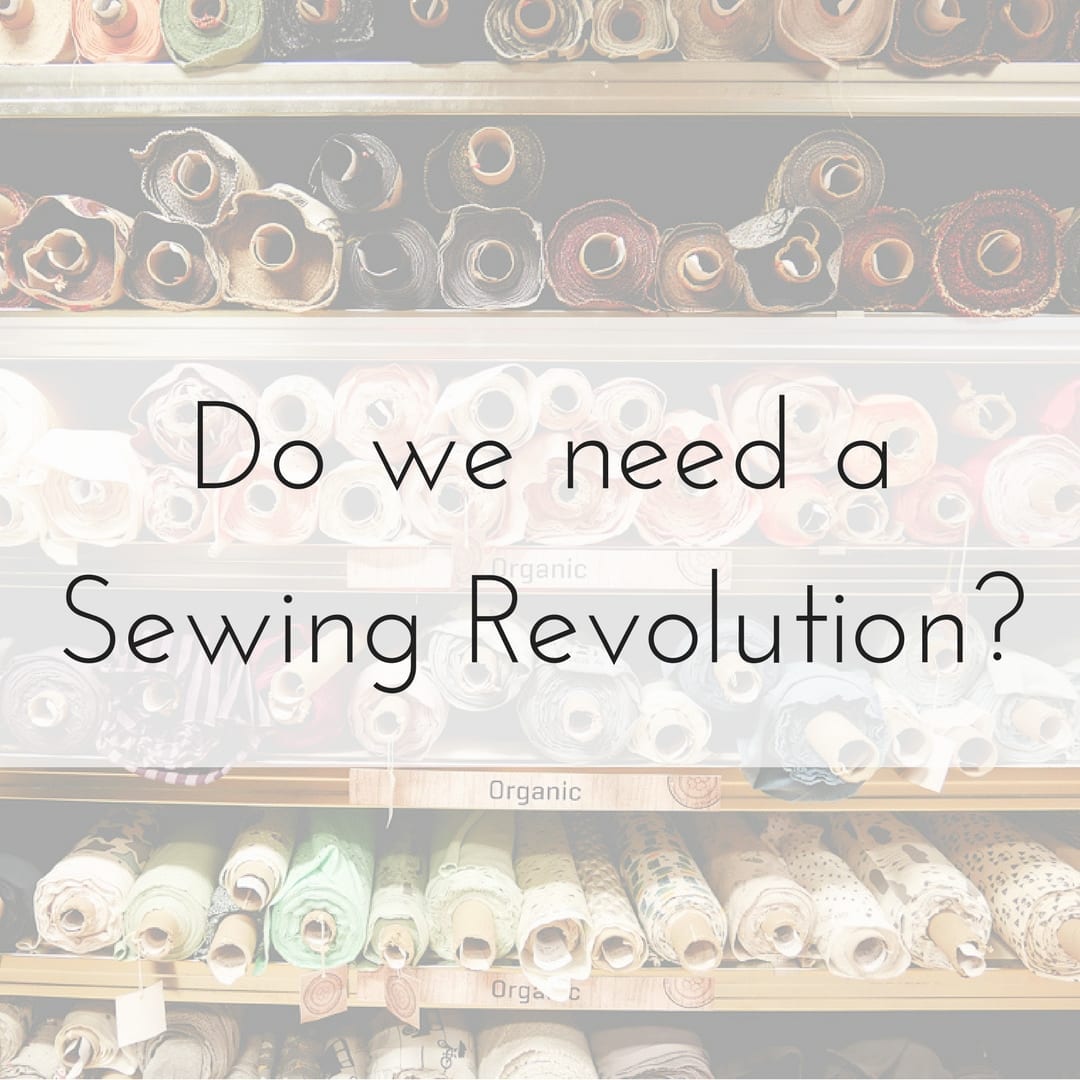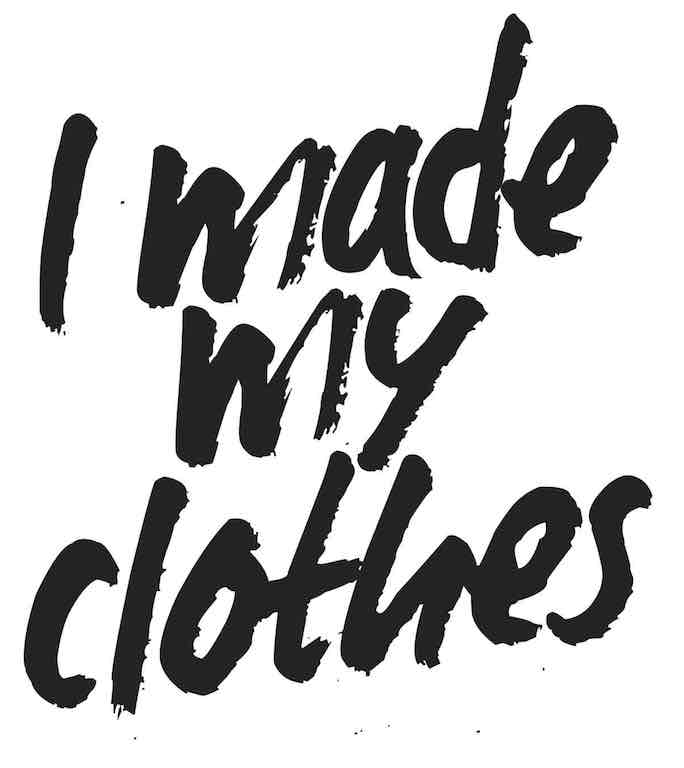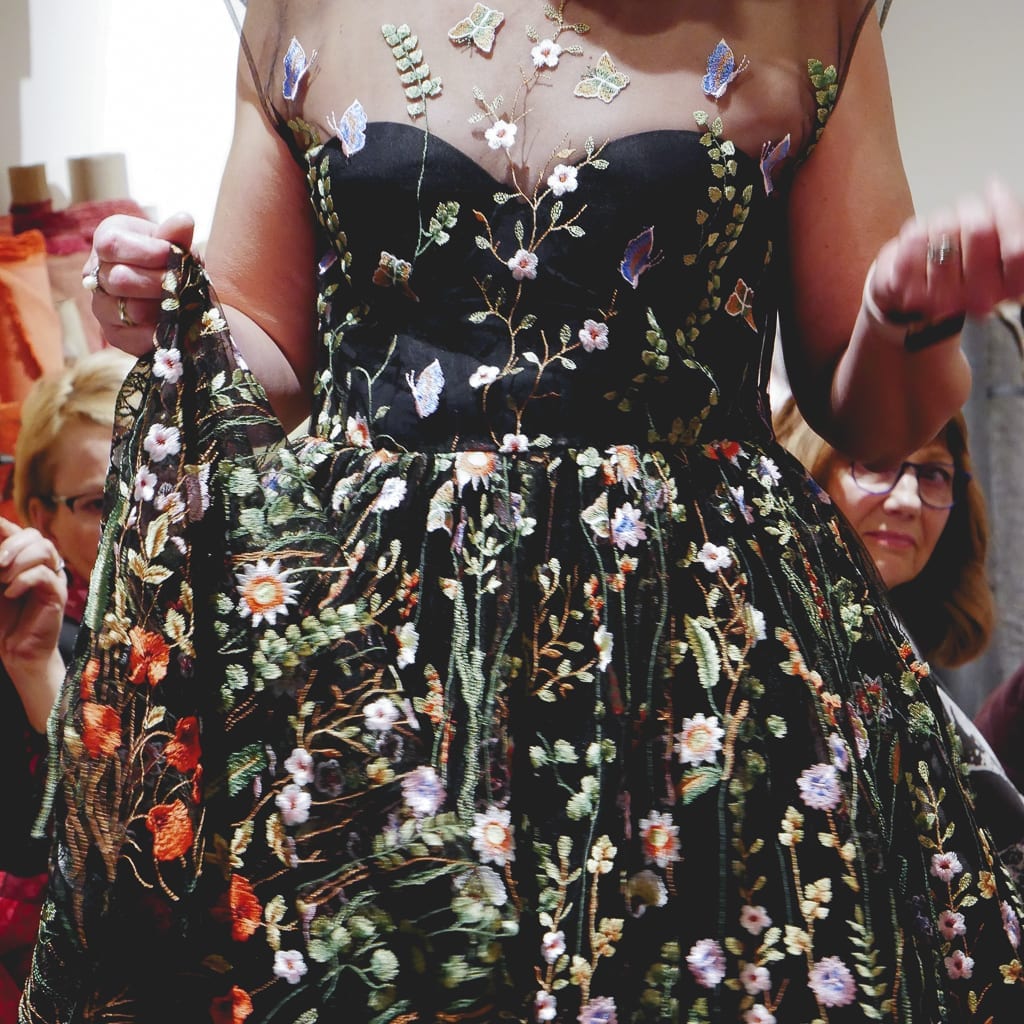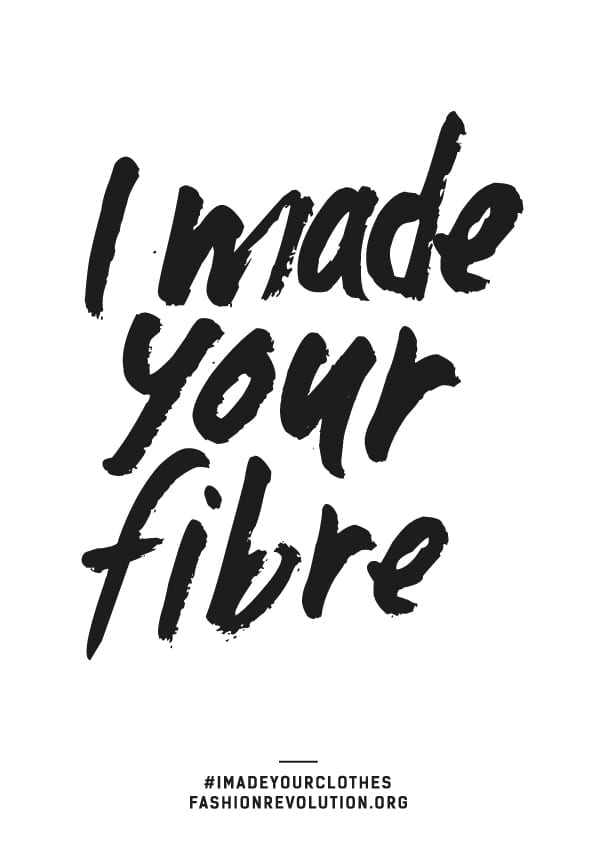‘
It’s Fashion Revolution week again. Created after the Rana Plaza disaster in Bangladesh that exposed the grim reality of many garment workers, Fashion Revolution is a movement pushing for transparency within the industry. When it comes to engagement with the public, Fashion Revolution encourages people to ask: “Who made my clothes”? This makes sense seeing as more people buy than sew their clothes. If we look a this question in isolation, the link between Fashion Revolution and the home sewer can be seen to be tenuous; after all, we can say #imademyclothes. But I think we could also be championing a sewing revolution.

A favourite of makers and sewers
A sewing revolution?
Let me start with my take on sewing culture. I have written before about fabric shopping culture and increased commercialism around sewing, but I suspect that within the UK indie market the just-make-more type of sewing attitude might have peaked. In the past few years I have watched social media and maker culture / DIY culture grow massively in the UK. The sewing pattern market is saturated with indie pattern designers (Fiona Parker of Diary of a Chainstitcher was already tracking her own mega list in 2015 and it just keeps growing). The selling point and marketing model for so many of them seems to be clear instructions, nice photos of real people (please catch up already Big 4!), and a lot of blogger led promotions on social media.
This also means there is inspiration to be had wherever you look, even if you are just sharing what you made on Facebook or Instagram or your blog. More often than not for me on social media, the feeling of “I want that” or “I can look like that” or “that’s a nice idea” kicks in. Seeing real people wear things that I can also make myself is infinitely more appealing than an airbrushed model and I know I am not alone in this.
But I would challenge how much I can feasibly sew and wear, how many sewing challenges can I do, how many patterns and fabrics I can buy. This sentiment is starting to be echoed more and I suspect the community is starting to experience some kind of fatigue. I know I am totally fatigued with new easy sews and would rather dream about fantastical creations like this one from Kathryn Brenne (it is even better in person than this photo that I took). Full details on the Emma One Sock blog here

Embroidered mesh dress, Kathryn Brenne
Sustainability is hot right now
I love that sustainability is hot. Running up to 2017, sustainable sewing was pretty much a non-topic. There was only a handful of well-known indie sewing figures talking about it (feel free to tell me that I was hanging with the wrong crowd on Instagram or reading the wrong blogs). But there has been an upsurge; Megan Nielsen and Love to Sew podcast are also on the sustainable sewing bandwagon, using up their stash and leftovers, building a capsule wardrobe etc. I have also seen a few other similarly themed sewing challenges.
The sustainability push makes sense if we consider it in a wider context of sustainable fashion, climate change, and environmental care becoming more mainstream. And of course, lets not forget David Attenborough’s Blue Planet II and the rippling effect it has had on our lives (long live David!) – have you ever seen retailers move so fast on plastic?!
Where is the transparency on our fabric supply chain?
Fashion Revolution action covers the whole fashion supply chain. In the world of home sewing, we are removing only the garment worker. There are still people who grow and make our fibre etc. but many of us probably don’t have this front and centre of our minds when we buy fabric. Whilst the average consumer can ask a brand “who made my clothes?” we still need to be asking who made my fibre? and happily I have seen people acknowledging this on social media.

What do we know about the person that holds up this poster?
Wendy Ward said in a recent interview for me that “the key to sustainable sewing is information” and I think she is spot on. How much do you know about your textiles? How many fabric stores can pinpoint where their fabrics come from and who made them? Do you ever ask? The couple of shops I did email did not respond to me or couldn’t tell me. A lot of places I know stock deadstock which is sometimes said to be a sustainable solution (justification on the IndieSew article here) but I suspect there are negatives as well which are worth considering at a later stage on this blog. Learning about textiles is high on my agenda, and I will be posting more on what I find. So far I have written posts on viscose, lyocell, recycled polyester, and a few FAQs on organic fabrics.
So what does a Sewing Revolution look like?
.At an individual level I think this will be different for everyone. At a sewing community level, I think a sewing revolution might already have started. Hopefully the current trend to be more mindful about the clothes we make and the fabrics we buy is set to continue! For myself, here’s the plan for the forseeable future:
- My sewing – minimal shopping (I’m 4 months without new to me fabric); planning my sewing so its not making for the sake of it; and a very slow project – more on that coming up soon!
- This time to sew blog – more textile info; sustainable fashion articles; interviews with cool people; and opinion pieces to encourage discussion.
- Community – #makeyourstash, more for the Sewcialists (if they’ll let me) and maybe a new tiny project…
Project Curious
Fashion Revolution encourages consumers to email this to their brands:
I am your customer, and I love your style. But I want to know more. I want to know#whomademyclothes.
I want to feel as good about the story behind my clothes as they make me feel when I wear them. I care deeply about the people who have worked so hard to make the things I buy from you. I want to know that they’re being treated fairly, have the freedom to speak out, and are paid enough to live with dignity, opportunity, comfort and hope. So tell me, what are you doing to ensure that the people who make your clothes are being paid a living wage?
I think this absolutely applies to us as makers and I want to have answers to all of these things. I have little hesitation in approaching established and well known textile designers / manufacturers such as Atelier Brunette, Art Gallery Fabrics, Robert Kaufmann, Liberty. But I have a dilemma with small indie sewing businesses that I want to support (e.g. fabric shops whose owners I know). Is it too much to ask of them to be probing and demanding like this when they are trying to make a living? What do you think? And please tell me – do you want answers to the Fashion Revolution questions? What do you want to know about your fabrics? Who are your favourite fabric brands that you would be interested in approaching?


15 comments
I’ve noticed some indie fabric sellers do post the country of origin for their fabrics but that doesn’t really tell us much UNLESS it is made in western countries like the UK, Europe or North America where labour and pollution standards are more stringent. Truthfully, how much are these standards really enforced? As consumers we like to believe they are but in truth, I know for a fact that in Canada they are not so I’m doubtful they are anywhere else. Standards and enforcement are two entirely different things. So the knowing WHERE your fabric is sourced from will not mean it’s meeting these standards. It will take much more work to identify the COMPANIES both in the east and west that are meeting them. There will need to be an international and independent investigative body launched that sets the standards and investigates claims of sustainability. To meet and keep the designation “organic food” is expensive and complex in Canada and it IS enforced at it’s launch. BUT for example, you can have an organic farm butted up next to one that isn’t and contamination does happen from one farm to the next. It’s all a rather slippery slope 🙂
Hi Kathleen, your comment on western countries sounds all too familiar. I have heard stories about brands going to great lengths to be able to say “made in” – check out this Reuters article as an example (though I appreciate it is a few years old). Yes I wonder whether my potential little project will do anything (does showing an interest count?) or would it just be a waste of time. I wrote recently to an eco label to complain about their marketing of bamboo and whilst they replied it was of course some meaningless generic statements… maybe I am better off carrying on here – probably a lot more worthwhile spending my time on this blog writing stuff to get the thinking juices going of the interested home sewer!
I have enjoyed reading your blog, and appreciate that it makes me think about my own clothing and fabric purchases.
Lately I have been noticing some bloggers who sew so many items that they couldn’t possibly wear them more than once or twice before there are new ones being added. This isn’t something to admire, but at least it is a reminder to me to be more thoughtful in my purchasing and sewing.
Keep up your good advice.
Hi there, thanks for your comment and very happy to hear that you have enjoyed reading my blog! I’m afraid to say I used to be like the bloggers you mention (except I didn’t blog) and at some point made a silly amount of clothing for no reason. My trigger to stop was my boyfriend saying “more fabric?” and I couldn’t even remember what I bought. It took me awhile but I have certainly changed my ways since then!
As a returning sewist I really appreciate the sharing of knowledge on blogs but it’s with a growing sense of horror to see so many blogs, Pattern Review and other sites where people are posting new makes every week, week after week. I’m not happy to see that the major fabric store chain in my region sells fabrics all from China. My last project took a month with hand quilting and embroidery surface design, a really satisfying and relaxing project. So I want to become more thoughtful and creative, taking my time will hopefully help that happen.
Hi Liese, you took the words out of my mouth! Whilst I am happy to see sewing becoming such a popular hobby I don’t want to see it become DIY fast fashion. But I have been guilty previously of being those bloggers that you mention, though I didn’t blog at the time. These days I have no clothes I need but I have loads of fabric in my stash – the “wardrobe gap” is a myth for me. So I tend to make simple projects so I can take my time with the finishings and really try and perfect them without the project feeling like it lasts forever. But I am thinking about a 100 hour project soon which I’ll blog more about in the near future! PS – I have a quilt for my son with loads of stitchery and appliqué. I’m not good at appliqué and so far the whole thing has been going for 2 years. Finding motivation is difficult, I really just need to get disciplined about it!
I don’t have any helpful suggestions but I am definitely interested to know who made my fabric! What and how the fabric shops and companies respond to your questions are not under your control, but the quality of their answer would give us an idea of their ethics in regard to sustainability. Although I appreciate that it’s difficult to then share such info to the public (your readers). But asking questions, raising awareness, individuals doing their part is the strart of any revolution, as you say it’s already happening.
Hi Sil, I think I need to think more about this one and what it would achieve. Because even if we know, does that serve a greater purpose? Lets say for example that we have one outstanding company and 5 less good companies. If the outstanding company sells stuff that isn’t desirable compared to the less sustainable companies, is that any good? Especially with small retailers, I don’t think they set out to be businesses selling unsustainable products; chances are there isn’t a lot of choice if you look at the immaturity of the sustainable fashion industry. I’m not sure if I”m making sense, all the thoughts swirling in my head are in a bit of a muddle tonight! X
I know what you mean, that’s why I have no real answers or suggestions myself ????????. I think questioning the big companies is the major step; they (theoretically) have the resources to source and stock some sustainable products or pick a more ethical suppliers involved in the production chain. Smaller companies, tricky! But even small things like clear labelling would help consumers make choices, without altering their own business dealings.
Thank you for your thoughtful and informative article. I returned to sewing last year, and I’m really glad I had been reading some sustainable, mindful and ethical focused lifestyle blogs. I had also shifted to a ‘buy no new unless absolutely necessary’ motto for myself. So I came to sewing with a lot of intention and desire to make good choices. I am lucky to have a great op shop nearby that always has fabric and notions, so most of my fabric is second hand. I have bought new fabric a few times and it made me uncomfortable due to the same issues you raised. I would love to read more of your journey of discovering the origins of our fibre and fabric. Thanks for trying and changing and inspiring.
Hi Melinda, thanks for reading and your kind feedback. I am aiming to write one post a month on fibres; I am sure you can appreciate it takes quite a bit of time but I do really enjoy doing it! So its nice to hear when other people are interested too. I have had 4 months off any fabric shopping and am thinking about where I am going to shop next. I’d quite like a piece of wool but I am hesitant to buy second hand online without being able to see a swatch. Do I take the plunge, buy something and then try and resell it if its not quite right? Do I go into my local warehouse staffed by two older men who had been selling cloth for 50 years and believe what they tell me? Or one of the lovely online shops run by people like me? One of the fabric shopping streets for overstock from any number of random shops but always feel a little suspicious about what they tell me? I’m not quite sure yet though I prefer the idea of second hand….
I think this is a complex issue for sewists. I had a similar epiphany last year when I realized I had replaced fast fashion bingeing with cheap fabric bingeing. I think it’s a fairly natural progression when learning to sew. You start with inexpensive low quality fabric because you are afraid of ruining the good stuff, then your skills expand to the point that you realize you have the ability to make anything you want and from that excitement comes a fury of sewing. I remember walking out of a fabric store, jacked up on a retail high with two big bags of fabric and justifying it to my mom by saying that it’s OK because I don’t shop for clothes anymore. A lot of that fabric is still sitting on my shelves! Since then I’ve tried to slow my whole sewing process down and to choose my fabric more carefully. But I tend to get frustrated and overwhelmed when looking into fabric production. It seems like every fabric is harmfully processed in some way, so it’s more of a “lesser of two evils” choice. More information would definitely help make that choice easier. Or maybe it would be even more complicated? Sigh. I usually end this cycle of thought with a pat on the back for making my own clothes in a more conscious way and leave it at that. A very long answer to your question, haha, but it’s a very comlex topic and always on my mind.
Hi Erin, its a familiar story for sure the cycle of learning to sew. There is a lot of information out there and not all of it clear whether it is greenwashing – and it certainly doesn’t help that there are no global standards for assessing things like sustainability. In terms of fabric info I tend to look at it like I read long news features, its interesting to learn a little about a topic that is related to what I do in my spare time and try and be a tiny more informed about my choices. Honestly though I believe that the best thing to do is buy nothing and sew nothing unless absolutely necessary – but thats not how it works right?! 😉 Thanks for your comment!
Interesting post as usual and most of my thoughts and ideas have been covered already but a couple of points
I know that following sewists and bloggers on IG has the disadvantage of making me more aware of all the desirable new patterns coming out but I hadn’t really registered that seeing ‘real people’ in clothes that I love and know that I could sew feeds into the over production of clothes that I make/want to make/have swilling around in my head. …but that is a very good point and one I will have to think about
The other point is a question. By ‘deadstock’ is this referring to the ‘designer’ fabrics that many fabric shops sell? I had been thinking about that. ..how we all feel we’re getting good quality fabric that is surplus to requirements. ..but do we know if the production of this fabric is any more sustainable than the fabric produced for fast fashion ?
So much food for thought.
Hi Judith, the real people point is probably why I always lean towards the indie patterns. On your headstock question – yes there are many fabric shops that might say ex-designer or say there are limited quantities available. For example last year there was a hugely popular Zara coat and the fabric was sold in shops. I saw both the coat and the fabric in person and it was the same pattern and texture so I reckon its a safe bet it was the same thing. I personally think sewing is highly connected to fashion. Without deadstock we would just be left with the textile designer stuff like Atelier Brunette or Liberty etc. Am currently writing a post on what I can find out about deadstock; stay tuned! X